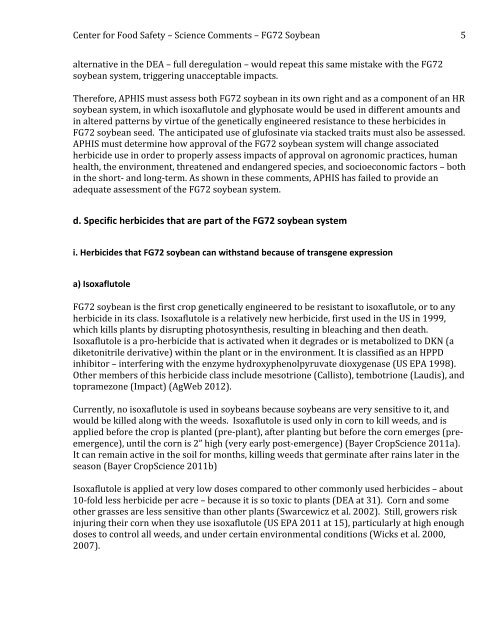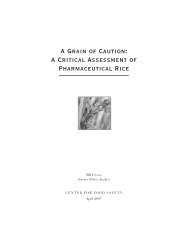a four-fold rise - Center for Food Safety
a four-fold rise - Center for Food Safety
a four-fold rise - Center for Food Safety
You also want an ePaper? Increase the reach of your titles
YUMPU automatically turns print PDFs into web optimized ePapers that Google loves.
<strong>Center</strong> <strong>for</strong> <strong>Food</strong> <strong>Safety</strong> – Science Comments – FG72 Soybean <br />
5 <br />
alternative in the DEA – full deregulation – would repeat this same mistake with the FG72 <br />
soybean system, triggering unacceptable impacts. <br />
There<strong>for</strong>e, APHIS must assess both FG72 soybean in its own right and as a component of an HR <br />
soybean system, in which isoxaflutole and glyphosate would be used in different amounts and <br />
in altered patterns by virtue of the genetically engineered resistance to these herbicides in <br />
FG72 soybean seed. The anticipated use of glufosinate via stacked traits must also be assessed. <br />
APHIS must determine how approval of the FG72 soybean system will change associated <br />
herbicide use in order to properly assess impacts of approval on agronomic practices, human <br />
health, the environment, threatened and endangered species, and socioeconomic factors – both <br />
in the short-‐ and long-‐term. As shown in these comments, APHIS has failed to provide an <br />
adequate assessment of the FG72 soybean system. <br />
d. Specific herbicides that are part of the FG72 soybean system <br />
i. Herbicides that FG72 soybean can withstand because of transgene expression <br />
a) Isoxaflutole <br />
FG72 soybean is the first crop genetically engineered to be resistant to isoxaflutole, or to any <br />
herbicide in its class. Isoxaflutole is a relatively new herbicide, first used in the US in 1999, <br />
which kills plants by disrupting photosynthesis, resulting in bleaching and then death. <br />
Isoxaflutole is a pro-‐herbicide that is activated when it degrades or is metabolized to DKN (a <br />
diketonitrile derivative) within the plant or in the environment. It is classified as an HPPD <br />
inhibitor – interfering with the enzyme hydroxyphenolpyruvate dioxygenase (US EPA 1998). <br />
Other members of this herbicide class include mesotrione (Callisto), tembotrione (Laudis), and <br />
topramezone (Impact) (AgWeb 2012). <br />
Currently, no isoxaflutole is used in soybeans because soybeans are very sensitive to it, and <br />
would be killed along with the weeds. Isoxaflutole is used only in corn to kill weeds, and is <br />
applied be<strong>for</strong>e the crop is planted (pre-‐plant), after planting but be<strong>for</strong>e the corn emerges (pre-emergence),<br />
until the corn is 2” high (very early post-‐emergence) (Bayer CropScience 2011a). <br />
It can remain active in the soil <strong>for</strong> months, killing weeds that germinate after rains later in the <br />
season (Bayer CropScience 2011b) <br />
Isoxaflutole is applied at very low doses compared to other commonly used herbicides – about <br />
10-‐<strong>fold</strong> less herbicide per acre – because it is so toxic to plants (DEA at 31). Corn and some <br />
other grasses are less sensitive than other plants (Swarcewicz et al. 2002). Still, growers risk <br />
injuring their corn when they use isoxaflutole (US EPA 2011 at 15), particularly at high enough <br />
doses to control all weeds, and under certain environmental conditions (Wicks et al. 2000, <br />
2007).







